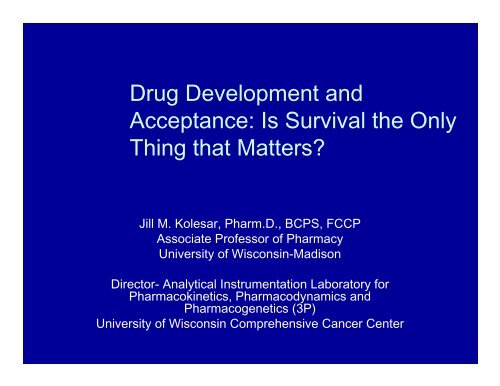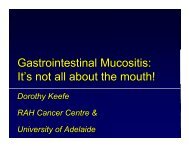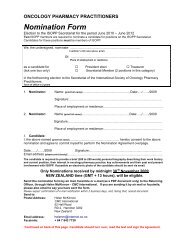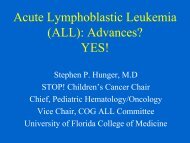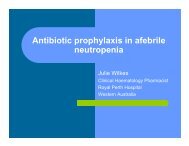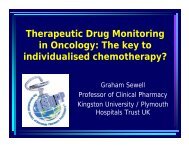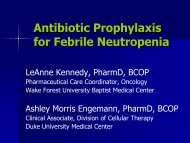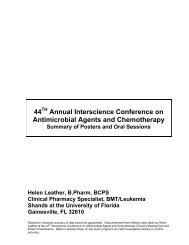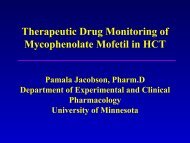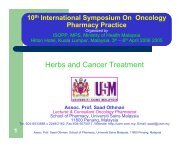Is Survival the Only Thing that Matters?
Is Survival the Only Thing that Matters?
Is Survival the Only Thing that Matters?
Create successful ePaper yourself
Turn your PDF publications into a flip-book with our unique Google optimized e-Paper software.
Drug Development and<br />
Acceptance: <strong>Is</strong> <strong>Survival</strong> <strong>the</strong> <strong>Only</strong><br />
<strong>Thing</strong> <strong>that</strong> <strong>Matters</strong>?<br />
Jill M. Kolesar, Pharm.D., BCPS, FCCP<br />
Associate Professor of Pharmacy<br />
University of Wisconsin-Madison<br />
Director- Analytical Instrumentation Laboratory for<br />
Pharmacokinetics, Pharmacodynamics and<br />
Pharmacogenetics (3P)<br />
University of Wisconsin Comprehensive Cancer Center
Outline<br />
• Goal of Drug Development<br />
• Phases of development<br />
– Typical endpoints<br />
– Alternative endpoints
Eschenbach, Plenary Presentation AACR Annual Meeting 2005
Eschenbach, Plenary Presentation AACR Annual Meeting 2005
Eschenbach, Plenary Presentation AACR Annual Meeting 2005
Eschenbach, Plenary Presentation AACR Annual Meeting 2005
Eschenbach, Plenary Presentation AACR Annual Meeting 2005
Oncology Drugs in Development<br />
900<br />
800<br />
700<br />
600<br />
500<br />
837<br />
Average time of clinical development<br />
Phase 1 to FDA approval= 10.8 yrs<br />
Average time at FDA= 1.6 yr<br />
400<br />
300<br />
200<br />
196<br />
219<br />
Clinical trials last 9 years, half of <strong>that</strong><br />
is Phase III<br />
100<br />
0<br />
Preclinical Phase 1 Phase 2 Phase 3<br />
67<br />
If we’re going to cure cancer by 2015<br />
we better start doing something new<br />
now!
Oncology: What is changing?<br />
• Combinational chemistry<br />
– More targets to screen<br />
– Typically generate >150,000 per year<br />
– Screened to find 50-100 most active<br />
• Molecular diagnosis<br />
• Targeted <strong>the</strong>rapies<br />
– Faster development<br />
– Bevacizumab<br />
• Less than 5 years<br />
–Imitinib<br />
• Less than 3 (2 months at <strong>the</strong> FDA)
Targeted Therapies<br />
• Extracellular inhibitors<br />
– Anti-angiogenic/antimetastatic drugs<br />
• Bevacizumab<br />
• Extra- and intracellular inhibitors<br />
– Inhibitory molecules of growth factor receptors<br />
• Erlotinib, gefitinib, cetuximab<br />
• Intracellular inhibitors<br />
– Agents against signal transduction, cell cycle<br />
inhibitors, agents targeting nuclear/extranuclear<br />
• Sorafenib
Who cares about endpoints?<br />
• Industry<br />
– Initial FDA approval>market niche<br />
• USA: FDA<br />
– Typically approves new drugs after phase III comparisons to standard of care<br />
– Patient benefit with favorable risk/benefit profile<br />
– Approvals are commonly based on phase II data and symptom control<br />
• O<strong>the</strong>r countries<br />
– Generally a decision of payer, whe<strong>the</strong>r <strong>the</strong>rapy makes clinical and economic<br />
sense<br />
– Same or more rigorous evaluation of efficacy and toxicity<br />
• Prescribers<br />
• Patient
Endpoints<br />
• Efficacy driven endpoints<br />
• <strong>Survival</strong><br />
– The real endpoint<br />
• Surrogate endpoints<br />
– response, progression free survival, disease free survival<br />
• Toxicity driven endpoints<br />
– Quality of life<br />
– Symptom control
Endpoints<br />
• Desired endpoints vary with phase of<br />
testing and clinical situation<br />
– Phase I vs III<br />
• Measure of exposure versus improved outcome<br />
– Adjuvant vs Metastatic<br />
• <strong>Survival</strong> vs quality of life or symptom control
Surrogate Markers<br />
• Replace a distal endpoint (survival) by proxy<br />
endpoint (response, biomarkers)<br />
• Benefits of using surrogate markers<br />
– Reduction in sample size<br />
– Reduction in trial duration<br />
– Reduction in cost<br />
– Reduction in time to evaluate new <strong>the</strong>rapies<br />
• Their use is NOT AS EASY AS IT SOUNDS…<br />
• Use of a marker as surrogate for outcome<br />
requires <strong>that</strong> you first identify one...
What is a surrogate marker?<br />
• Defining Characteristic:<br />
– a marker must predict clinical outcome, in<br />
addition to predicting <strong>the</strong> effect of treatment<br />
on clinical outcome<br />
• Operational Definition<br />
– establish an association between marker &<br />
clinical outcome<br />
– establish an association between marker,<br />
treatment & clinical outcome, in which marker<br />
mediates relationship between clinical<br />
outcome and treatment
Surrogate Markers<br />
1) establish an association between marker & clinical outcome.<br />
marker<br />
Clinical<br />
outcome<br />
2) establish an association between marker, treatment &<br />
clinical outcome, in which marker completely mediates<br />
relationship between clinical outcome and treatment.<br />
treatment<br />
marker<br />
Clinical<br />
outcome
Correlative Studies<br />
• It is still valid to look at<br />
markers <strong>that</strong> you would<br />
expect to be correlated<br />
with <strong>the</strong> clinical<br />
outcome.<br />
• But, we do not want to be<br />
overconfident by saying<br />
<strong>that</strong> <strong>the</strong>y are true<br />
‘surrogates.’<br />
• Correlative studies might<br />
include:<br />
– Pharmacokinetics<br />
– Pharmacodynamics<br />
– O<strong>the</strong>r biologic markers <strong>that</strong><br />
can be measured in serum,<br />
biopsy samples, etc.<br />
treatment<br />
Clinical<br />
outcome<br />
marker
Characteristics of Oncology Trials<br />
Phase I<br />
Phase II<br />
Phase III<br />
Number of<br />
patients<br />
20-30<br />
30-100<br />
200-5000<br />
Primary Endpoints<br />
Maximum<br />
tolerated dose<br />
Response rate<br />
Time to tumor<br />
progression<br />
<strong>Survival</strong><br />
Quality of life<br />
Time to tumor<br />
progression<br />
Cost per patient<br />
100<br />
75<br />
64<br />
Cost per phase<br />
10<br />
22<br />
100
Phase I Endpoints<br />
•The only reason to do a phase I study is to<br />
determine <strong>the</strong> dose and schedule for<br />
phase II testing<br />
– MTD is a good surrogate for <strong>the</strong> phase II dose<br />
in cytotoxic agents<br />
– For non cytotoxic agents a measure of<br />
exposure may be more appropriate surrogate
Phase I Endpoints<br />
• Examples of non MTD exposure end<br />
points<br />
– Pharmacokinetics<br />
• Carboplatin and AUC<br />
– Pharmacodynamics<br />
• Bortezomib and proteosome inhibition<br />
– Genetic polymorphims<br />
• 6-MP and TPMT polymorphisms
Phase II<br />
• The purpose of a phase II is to<br />
demonstrate efficacy, <strong>the</strong>refore survival or<br />
a surrogate of survival is required<br />
– <strong>Survival</strong> may be difficult to demonstrate if<br />
• Long natural history of <strong>the</strong> cancer<br />
• Small sample size or limited activity<br />
• Anti-cancer agents are commonly<br />
approved based on phase II data
Agents Approved on Phase II<br />
Response Data<br />
• Rituximab<br />
• Capecitabine<br />
• Trastuzumab<br />
• Temozolamide<br />
• Gefitinib (failed in subsequent phase II<strong>Is</strong>)<br />
• Imitinib<br />
• Topetecan<br />
• Irinotecan<br />
• Docetaxel
Classification of Standard<br />
Cytotoxics<br />
Activity<br />
Large<br />
Small<br />
Toxicity<br />
Significant<br />
Trade-offs<br />
Attempt to manage<br />
toxicity<br />
Castaway<br />
Discontinue Development<br />
Modest<br />
Superstar<br />
May be approved on<br />
phase II data<br />
Incrementalist<br />
Take to phase III if<br />
treatment void
Classification of Targeted Therapies<br />
Toxicity<br />
Strong<br />
Evidence of<br />
Tumor<br />
Regression<br />
Modest<br />
activity, good<br />
pks<br />
Target<br />
inhibition<br />
Target<br />
inhibition<br />
No biological<br />
activity<br />
Significant<br />
Trade-offs<br />
?Castaway<br />
Castaway<br />
Castaway<br />
Manage<br />
toxicity,<br />
consider<br />
phase III<br />
Consider<br />
phase back to<br />
phase I-II<br />
Modest<br />
Superstar<br />
Incrementalist<br />
Incrementalist<br />
Castaway<br />
May approved<br />
on phase II<br />
data<br />
Consider for<br />
phase III<br />
Consider for<br />
phase III if tx<br />
void
Study Endpoints- Response Rates<br />
• Response rates (RR)<br />
– Based on tumor measurements from anatomical<br />
imaging<br />
– RR is <strong>the</strong> likelihood <strong>that</strong> <strong>the</strong> tumor will shrink or<br />
disappear based on observations in a significant<br />
group of patients.<br />
• Response Evaluation Criteria in Solid Tumors<br />
(RECIST)
RECIST Responses<br />
* Complete<br />
Response<br />
(CR):<br />
* Partial<br />
Response<br />
(PR):<br />
* Progressive<br />
Disease (PD):<br />
* Stable<br />
Disease (SD):<br />
Disappearance of all target lesions<br />
At least a 30% decrease in <strong>the</strong> sum of <strong>the</strong><br />
LD of target lesions, taking as reference <strong>the</strong><br />
baseline sum LD<br />
At least a 20% increase in <strong>the</strong> sum of <strong>the</strong><br />
LD of target lesions, taking as reference <strong>the</strong><br />
smallest sum LD recorded since <strong>the</strong><br />
treatment started or <strong>the</strong> appearance of one<br />
or more new lesions<br />
Nei<strong>the</strong>r sufficient shrinkage to qualify for PR<br />
nor sufficient increase to qualify for PD,<br />
taking as reference <strong>the</strong> smallest sum LD<br />
since <strong>the</strong> treatment started
Phase III Endpoints<br />
• The purpose of a phase III is to compare<br />
<strong>the</strong> new treatment to <strong>the</strong> standard <strong>the</strong>rapy,<br />
<strong>the</strong>refore <strong>the</strong> current standard <strong>the</strong>rapy<br />
dictates <strong>the</strong> endpoints<br />
– If <strong>the</strong>re is no standard <strong>the</strong>rapy<br />
– In <strong>the</strong> metastatic setting, symptom control and<br />
quality of life are very important<br />
– In <strong>the</strong> adjuvant setting, survival is important
Study Endpoints- <strong>Survival</strong><br />
• Overall survival<br />
• Disease-free survival (DFS): Ma<strong>the</strong>matical curve<br />
estimating <strong>the</strong> % of subjects <strong>that</strong> will survive and be<br />
disease free at various periods of time after initial<br />
treatment.<br />
– Patients must be disease free at some time during treatment for<br />
this to be valid<br />
• Progression-free survival (PFS): Ma<strong>the</strong>matical curve<br />
estimating <strong>the</strong> percentage of patients who will survive<br />
and be without evidence of disease progression at<br />
various time periods after initial treatment
Study Endpoints-<strong>Survival</strong><br />
Total Mortality (or overall survival from a defined point in<br />
time) - This outcome is arguably <strong>the</strong> most important one<br />
to patients and is also <strong>the</strong> most easily defined and least<br />
subject to investigator bias.<br />
Cause-Specific Mortality (or cause-specific mortality from a<br />
defined point in time) - Although this may be of <strong>the</strong> most<br />
biologic importance in a disease-specific intervention, it<br />
is a more subjective end point than total mortality and<br />
more subject to investigator bias in its determination. It<br />
may also miss important effects of <strong>the</strong>rapy <strong>that</strong> may<br />
actually shorten overall survival
Study Endpoints- O<strong>the</strong>rs<br />
Carefully Assessed Quality of Life - This is an extremely<br />
important end point to patients. May be used alone or<br />
in conjunction with objective response rates to support<br />
drug approvals<br />
Symptom Control<br />
Biomarkers- Pharmacokinetics, pharmacodynamics,<br />
pharmacogenetics<br />
Clinical Benefit
Case #1<br />
• Gemcitabine for <strong>the</strong> treatment of<br />
pancreatic cancer<br />
– Pancreas cancer in all stages universally fatal<br />
within 5 years, despite numerous clinical trials<br />
and interventional strategies<br />
– Target symptoms of pancreas cancer are<br />
pain, weight loss and decreased activities
Case #1<br />
– Since no agent had<br />
ever improved survival<br />
or had responses in<br />
pancreas cancer <strong>the</strong><br />
FDA decided <strong>that</strong><br />
clinical benefit was<br />
reason for approval<br />
– Trial compared<br />
gemcitabine to 5FU<br />
with clinical benefit as<br />
primary endpoint<br />
Clinical<br />
benefit<br />
Time to<br />
progression<br />
Median<br />
survival<br />
5FU<br />
4.8%<br />
1<br />
4.41<br />
Gem<br />
23.8%<br />
3.2<br />
5.65<br />
P value<br />
0.0022<br />
0.0002<br />
0.0025
Conclusions<br />
• Targeted <strong>the</strong>rapies speed drug<br />
development<br />
• Targeted <strong>the</strong>rapies may require alternative<br />
endpoint evaluation<br />
• Want my slides?<br />
jmkolesar@pharmacy.wisc.edu


